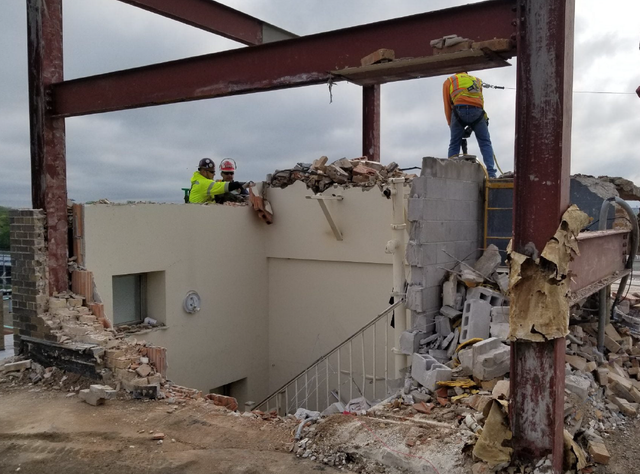Environmental Sustainability in Interior Demolition: Strategies for Liable Practices
Environmental Sustainability in Interior Demolition: Strategies for Liable Practices
Blog Article
The Ultimate Guide to Interior Demolition Techniques and Equipments
Within the realm of indoor remodellings, the art of demolition is an essential phase that calls for accuracy, skill, and the right set of tools. Whether you are an experienced expert or a DIY fanatic, comprehending the details of interior demolition techniques can make all the distinction in attaining an effective job end result.
Crucial Indoor Demolition Devices
When carrying out interior demolition tasks, having the suitable tools is crucial for efficiency and security. Among the most critical devices for interior demolition is the demolition hammer. This heavy-duty tool is designed to appear hard materials like drywall, concrete, and floor tile. Its effective hammering action can promptly knock down wall surfaces, floorings, and other frameworks. Furthermore, a crowbar is vital for removing fixtures, trim, and other products. Its leverage allows for the simple extraction of nails and other bolts without harming the surrounding surfaces - interior demolition.
One more essential tool is a reciprocating saw, which is best for puncturing a variety of products such as plastic, steel, and timber. Its capacity to make precise cuts in limited rooms makes it ideal for demolition job. Additionally, an energy blade is required for cutting products like rug, plastic flooring, and insulation. Its sharp blade makes certain tidy and accurate cuts, assisting in the elimination of unwanted materials. Overall, having these vital indoor demolition tools will substantially improve the effectiveness and security of any type of demolition task.

Safety And Security Preventative Measures Throughout Demolition

Furthermore, all workers entailed in the demolition procedure must obtain appropriate training on the appropriate handling of devices and equipment to lessen mishaps. By sticking to these safety preventative measures, indoor demolition tasks can be carried out successfully while focusing on the well-being of all individuals involved.
Strategies for Eliminating Wall Surfaces
Implementing correct safety and security preventative measures throughout indoor demolition jobs is vital for developing a safe and secure functioning setting, and one vital aspect of such projects involves understanding techniques for getting rid of wall surfaces. One generally used technique is manual demolition, which requires the use of standard hand tools such as sledgehammers, crowbars, and energy blades to carefully take down the wall piece by piece. This method permits for better control over the demolition procedure, specifically in fragile locations where accuracy is crucial.
For bigger, much more complicated wall surfaces, mechanical demolition might be essential. This entails utilizing heavy machinery like bulldozers or excavators to knock down wall surfaces successfully. However, it is crucial to make sure that the architectural stability of the building is not jeopardized during mechanical demolition.
An additional strategy for removing walls is deconstruction, where the wall surface is disassembled in a manner that maintains recyclable materials. This sustainable approach is pop over here eco-friendly and can likewise assist lower disposal expenses. Whichever strategy is employed, it is vital to follow appropriate safety protocols and think about the structural ramifications of wall surface removal to make certain an effective interior demolition job.
Removing Flooring Like a Pro
Effectively getting rid of flooring during interior demolition needs the appropriate devices and strategies to make sure a smooth and successful process. The very first action in removing floor covering is to clear the area of any furnishings or barriers. Next off, identify the sort of flooring to identify the suitable elimination technique. For wood or laminate floor covering, begin by removing the walls and after that make use of a flooring scraper to lift and separate the planks. Rug elimination includes cutting the carpet into manageable sections and rolling it up for disposal. For ceramic tile or vinyl flooring, a carve or flooring scrape original site can be utilized to pry up the tiles or sheets. It's important to wear protective gear such as gloves, goggles, and a mask to stop injuries and exposure to dust and debris. Additionally, having a dumpster or assigned disposal location prepared for the removed floor covering products is essential for maintaining a clean job environment. By following these strategies and using the right tools, eliminating floor covering like a pro can be accomplished efficiently and properly.
Proper Waste Disposal Approaches
After efficiently removing flooring utilizing the proper devices and methods, the following essential step in the indoor demolition process is implementing correct waste disposal approaches. Appropriate waste disposal is necessary for keeping a clean and risk-free job environment throughout and after demolition.

Contractors must follow neighborhood regulations relating to garbage disposal to avoid penalties and fines. Utilizing news specialist waste administration services can improve the disposal process and guarantee compliance with environmental guidelines. By applying correct waste disposal techniques, indoor demolition projects can be finished successfully and sustainably.
Final Thought
In conclusion, interior demolition calls for the usage of vital devices and stringent safety and security preventative measures to make sure a successful and risk-free procedure. By complying with these standards, interior demolition can be completed effectively and with marginal dangers.
One of the most important tools for interior demolition is the demolition hammer (interior demolition). Overall, having these important interior demolition devices will considerably boost the efficiency and safety of any type of demolition job
Successfully eliminating floor covering during interior demolition calls for the correct tools and strategies to make sure a smooth and successful process.After effectively getting rid of floor covering making use of the proper tools and methods, the next important action in the indoor demolition process is executing appropriate waste disposal approaches.In final thought, indoor demolition needs the use of essential devices and strict security preventative measures to guarantee a successful and safe procedure.
Report this page